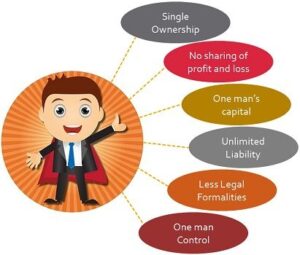![]()
![]()
![]()

Introduction
How do I register a company as a sole proprietorship:-A sole proprietorship is the simplest and most common form of business structure owned and operated by a single individual. It is easy to set up and requires minimal formalities, making it an ideal choice for small business owners and entrepreneurs. This article provides a step-by-step guide on how to register a sole proprietorship, along with its benefits, usage, limitations, and key considerations.
Definition of Sole Proprietorship
A sole proprietorship is a business structure where an individual owns and manages the business without any legal distinction between the owner and the business entity. This means that the owner is personally responsible for all business debts and liabilities.
User Intent: Why Register a Sole Proprietorship?
Entrepreneurs opt for a sole proprietorship for several reasons, including:
- Ease of setup and minimal legal requirements.
- Full control over business decisions.
- Simplified tax reporting.
- Lower operational costs.
Steps to Register a Sole Proprietorship
- Choose a Business Name – Select a unique and appropriate name for your business.
- Check Name Availability – Verify that your business name is not already in use by checking with the relevant local authority.
- Register the Business Name – If required, register the name with the local government or business registry.
- Obtain Necessary Licenses and Permits – Depending on the nature of your business, acquire necessary permits and licenses.
- Register for Taxes – Obtain a tax identification number (TIN) and register for applicable taxes, such as sales tax or business tax.
- Open a Business Bank Account – Keep business and personal finances separate by opening a dedicated bank account.
- Comply with Local Regulations – Ensure that you meet zoning, labor, and other legal requirements.
Benefits of a Sole Proprietorship
- Easy and Quick Registration – Requires minimal paperwork and legal formalities.
- Full Control – The owner has complete decision-making authority.
- Low Startup Costs – Fewer fees and no need for complex legal structures.
- Simplified Taxation – Business income is taxed as personal income, avoiding corporate tax rates.
- Flexibility – The owner can easily make changes or dissolve the business.
Usage of Sole Proprietorship
- Freelancers and Consultants – Writers, designers, and consultants benefit from easy tax filing and minimal paperwork.
- Small Retail Businesses – Local stores, boutiques, and online sellers prefer this structure for its simplicity.
- Service Providers – Electricians, plumbers, and other tradespeople operate efficiently under this model.
- Home-Based Businesses – Ideal for entrepreneurs starting from home with limited capital.
Limitations of a Sole Proprietorship
- Unlimited Liability – The owner is personally responsible for all business debts.
- Limited Growth Potential – Raising capital can be challenging as investors prefer incorporated businesses.
- Tax Burden – Business income is subject to personal income tax rates, which may be higher in some cases.
- Lack of Business Continuity – The business ceases to exist if the owner retires or passes away.
- Limited Credibility – Some clients and suppliers may prefer working with incorporated businesses.
Comparative Table: Sole Proprietorship vs. Other Business Structures
| Feature | Sole Proprietorship | Partnership | Corporation |
|---|---|---|---|
| Ownership | Single individual | Two or more individuals | Shareholders |
| Liability | Unlimited | Shared among partners | Limited to investment |
| Registration | Simple | Moderate | Complex |
| Taxation | Personal income tax | Pass-through taxation | Corporate tax rates |
| Control | Full control | Shared decision-making | Board of Directors |
| Business Continuity | Ends with owner | May continue if structured properly | Perpetual existence |
Conclusion
Registering a sole proprietorship is a straightforward and cost-effective way to start a business. It offers simplicity, full control, and ease of taxation, making it an attractive option for small businesses and solo entrepreneurs. However, it comes with challenges such as unlimited liability and limited access to funding. Understanding these aspects can help entrepreneurs make informed decisions about their business structure.

For further details access our website: https://vibrantfinserv.com